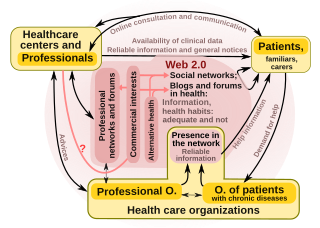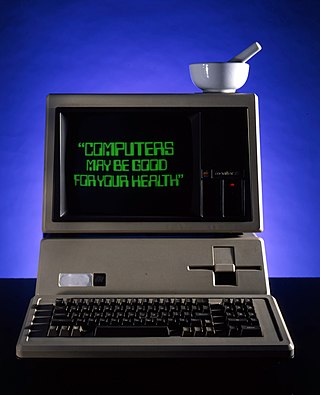Related Research Articles
A health system, health care system or healthcare system is an organization of people, institutions, and resources that delivers health care services to meet the health needs of target populations.

Health informatics is the study and implementation of computer structures and algorithms to improve communication, understanding, and management of medical information. It can be view as branch of engineering and applied science.
A medical error is a preventable adverse effect of care ("iatrogenesis"), whether or not it is evident or harmful to the patient. This might include an inaccurate or incomplete diagnosis or treatment of a disease, injury, syndrome, behavior, infection, or other ailment.

Renato Marcos Endrizzi Sabbatini is a retired professor at the Department of Biomedical Engineering and at the State University of Campinas Institute of Biology. He received a B.Sc. in Biomedical Sciences from Medical School of the University of São Paulo and a doctorate in behavioral neuroscience in 1977, followed by postdoctoral work at the Max Planck Institute of Psychiatry's Primate Behavior Department. He founded the Center for Biomedical Informatics, and helped create the Brazilian Society for Health Informatics.
The International Medical Informatics Association (IMIA) is an independent organization that plays a role in promoting and furthering the application of information science in modern society, particularly in the fields of healthcare, bioscience and medicine. It was established in 1967 as a technical committee of the International Federation for Information Processing (IFIP). It became an independent organization in 1987 and was established under Swiss law in 1989.
A personal health record (PHR) is a health record where health data and other information related to the care of a patient is maintained by the patient. This stands in contrast to the more widely used electronic medical record, which is operated by institutions and contains data entered by clinicians to support insurance claims. The intention of a PHR is to provide a complete and accurate summary of an individual's medical history which is accessible online. The health data on a PHR might include patient-reported outcome data, lab results, and data from devices such as wireless electronic weighing scales or from a smartphone.

A health or medical library is designed to assist physicians, health professionals, students, patients, consumers, medical researchers, and information specialists in finding health and scientific information to improve, update, assess, or evaluate health care. Medical libraries are typically found in hospitals, medical schools, private industry, and in medical or health associations. A typical health or medical library has access to MEDLINE, a range of electronic resources, print and digital journal collections, and print reference books. The influence of open access (OA) and free searching via Google and PubMed has a major impact on the way medical libraries operate.
A medical writer, also referred to as medical communicator, is a person who applies the principles of clinical research in developing clinical trial documents that effectively and clearly describe research results, product use, and other medical information. The medical writer develops any of the five modules of the Common Technical Document. The medical writers also ensure that their documents comply with regulatory, journal, or other guidelines in terms of content, format, and structure.
Health information management (HIM) is information management applied to health and health care. It is the practice of analyzing and protecting digital and traditional medical information vital to providing quality patient care. With the widespread computerization of health records, traditional (paper-based) records are being replaced with electronic health records (EHRs). The tools of health informatics and health information technology are continually improving to bring greater efficiency to information management in the health care sector.

The Indian Association for Medical Informatics (IAMI) is a professional society that plays a role in promoting and furthering the application of informatics in the fields of healthcare, bioscience and medicine in India. It was established in Feb 1993 by Prof. Dr. Nanduri Gajanana Rao BSc, MBBS, MNAMS, PhD at Nizam's Institute of Medical Sciences, Hyderabad. Registered at District Registrar of Societies on 18 Sep 1993 - Regn No. 3774/93

Gunther Eysenbach is a German-Canadian researcher on healthcare, especially health policy, eHealth, and consumer health informatics.

"Health 2.0" is a term introduced in the mid-2000s, as the subset of health care technologies mirroring the wider Web 2.0 movement. It has been defined variously as including social media, user-generated content, and cloud-based and mobile technologies. Some Health 2.0 proponents see these technologies as empowering patients to have greater control over their own health care and diminishing medical paternalism. Critics of the technologies have expressed concerns about possible misinformation and violations of patient privacy.
Drug discovery and development requires the integration of multiple scientific and technological disciplines. These include chemistry, biology, pharmacology, pharmaceutical technology and extensive use of information technology. The latter is increasingly recognised as Pharmacoinformatics. Pharmacoinformatics relates to the broader field of bioinformatics.
Health information technology (HIT) is health technology, particularly information technology, applied to health and health care. It supports health information management across computerized systems and the secure exchange of health information between consumers, providers, payers, and quality monitors. Based on a 2008 report on a small series of studies conducted at four sites that provide ambulatory care – three U.S. medical centers and one in the Netherlands, the use of electronic health records (EHRs) was viewed as the most promising tool for improving the overall quality, safety and efficiency of the health delivery system.

The Health Informatics Society of Australia Ltd (HISA) is a scientific society, established in 1992, for health informaticians and those with an interest in health informatics.
Informatics for Consumer Health (ICH) is a government initiative coordinated by the National Cancer Institute (NCI) within the National Institutes of Health (NIH). ICH focuses on a coordination of health information, technology, and health care delivery that empowers providers to manage care and increases the ability of consumers to gain mastery over their own health. The ICH online initiative involved stakeholders from various sectors—commercial IT, government, health care, education, research, and advocacy—exchanging ideas and resources to bridge information technology and health care with the goal of improving behavioral support for all consumers. The Informatics for Consumer Health field is related to health informatics, medical informatics, consumer health informatics, eHealth, and health information technology.
Health care quality is a level of value provided by any health care resource, as determined by some measurement. As with quality in other fields, it is an assessment of whether something is good enough and whether it is suitable for its purpose. The goal of health care is to provide medical resources of high quality to all who need them; that is, to ensure good quality of life, cure illnesses when possible, to extend life expectancy, and so on. Researchers use a variety of quality measures to attempt to determine health care quality, including counts of a therapy's reduction or lessening of diseases identified by medical diagnosis, a decrease in the number of risk factors which people have following preventive care, or a survey of health indicators in a population who are accessing certain kinds of care.

Health information on the Internet refers to all health-related information communicated through or available on the Internet.
Health data is any data "related to health conditions, reproductive outcomes, causes of death, and quality of life" for an individual or population. Health data includes clinical metrics along with environmental, socioeconomic, and behavioral information pertinent to health and wellness. A plurality of health data are collected and used when individuals interact with health care systems. This data, collected by health care providers, typically includes a record of services received, conditions of those services, and clinical outcomes or information concerning those services. Historically, most health data has been sourced from this framework. The advent of eHealth and advances in health information technology, however, have expanded the collection and use of health data—but have also engendered new security, privacy, and ethical concerns. The increasing collection and use of health data by patients is a major component of digital health.

Marion Jokl Ball is a South African born United States (U.S.) citizen, scientist, educator, and leader in global Biomedical and Health Informatics. She holds the Raj and Indra Nooyi Endowed Distinguished Chair in Bioengineering, University of Texas at Arlington, is Presidential Distinguished Professor, College of Nursing and Health Innovation and serves as the Founding Executive Director, Multi-Interprofessional Center for Health Informatics (MICHI), University of Texas at Arlington. She is Professor Emerita, Johns Hopkins University School of Nursing and Affiliate Professor, Division of Health Sciences Informatics, Johns Hopkins School of Medicine. A member of the National Academy of Medicine (NAM), she is a pioneers of Informatics in Nursing and in Medicine and a founding member of the Technology Informatics Guiding Education Reform (TIGER), a global grassroots initiative that formalized in 2006 to enable nurses and later, the multi-interdisciplinary healthcare workforce in 34 countries to best make use of Health Informatics principles, methods, tools, and resources. Ball is the author/editor of over 35 books and over 200 articles in the field of Health Informatics.
References
- ↑ IMIA, CHIWG. "Consumer Health Informatics". IMIA. Archived from the original on 7 March 2015. Retrieved 8 January 2015.
- ↑ BMJ 2000; 320 : 1713 doi : 10.1136/bmj.320.7251.1713 (Published 24 June 2000)[ full citation needed ]
- ↑ American Medical Informatics Association. "Consumer Health Informatics", Bethesda, Maryland 2014. Retrieved on 20 October 2014.
- 1 2 Biomedical Informatics by Shortliffe and Cimino (3rd Edition)[ full citation needed ]